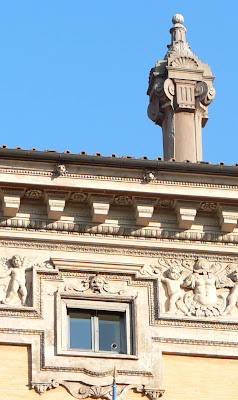
This past weekend we went to Naples for an overnight visit. In July we were there to catch a ferry to Sicily, making my view of Naples one with lots of traffic and a bustling port. Walking the streets and strolling the piazzas as we explored the center of Naples has given me a very different feeling about this city.
On Saturday afternoon we made our way to Via San Gregorio Armeno for the Christmas Market. This long narrow cobblestone street is filled with little shops and bancarelle (stalls) that are filled with terra cotta and plastic figures Nativity scenes.

There are stables and empty village scenes for people to buy and fill with the Holy Family, angels, shepherds, wise men and animals. The street was crowded with tourists and Neapolitans who have come to buy new pieces to add to their precipio displays at home.


Several years ago I started my own small precipio with parts I bought in New York City. In 1990, while visiting Mexico City, I got an Italian made figure of two children with a mother, representing my two kids and their mother. Two years ago in Rome, I added a musician for Vincenzo and last year I added a small rabbit for his pet, Zic. This year, on the Via San Gregoria Armeno, I have added figures representing three special people in New York. My friend Paul is a nurse, and I found a figure holding a touch, making me think of Florence Nightingale. I found two figures as images for John and Michael: a young shepherd for John and a slightly older shepherd for Michael. They are a very caring couple, like shepherds. (And then for me, I found a chubby guy sitting down with his pants rolled up.)
Dinner on Saturday night was at a fun restaurant.

I have never seen so much buffalo on a menu. Our appetizer was buffalo mozzarella served with sliced cherry tomatoes and basil. My main course was a buffalo fillet with a mixed salad and potatoes. I ended the meal with a dessert of buffalo cheesecake. (It was not a New York cheesecake, but with the buffalo ricotta it was delicious!)
On Sunday we made our way to the Church of Santa Chiara. For me the cloister behind the church is a real jewel of Naples. It was built in 1740 and was part of the enclosed convent of the Poor Clares. The columns and benches are covered with colorful majolica tiles. While the frescoes on the inner walls of the cloister (from the 1600's) show scenes from the Bible and the life of the Franciscans, the tiles in the cloister represent what happens outside the monastery.

On the benches and walls there are rural countryside scenes of hunting, work and play. There are also mythological episodes depicted on some of the tiles. The tiled columns that are decorated with vines, oranges, lemons, bananas and figs enhance the restful nature of the cloister.

Let me close with an Italian song from the 1940’s. In the refrain an immigrant talks about the Santa Chiara monastery. He says that his heart is sad and heavy because every night he thinks about how his city used to be.
Go to: http://www.italiamerica.org/Munasterio_'Santa_Chiara.htm
It reminds me of the American song "When the Swallows Come Back to Capistrano."



















































